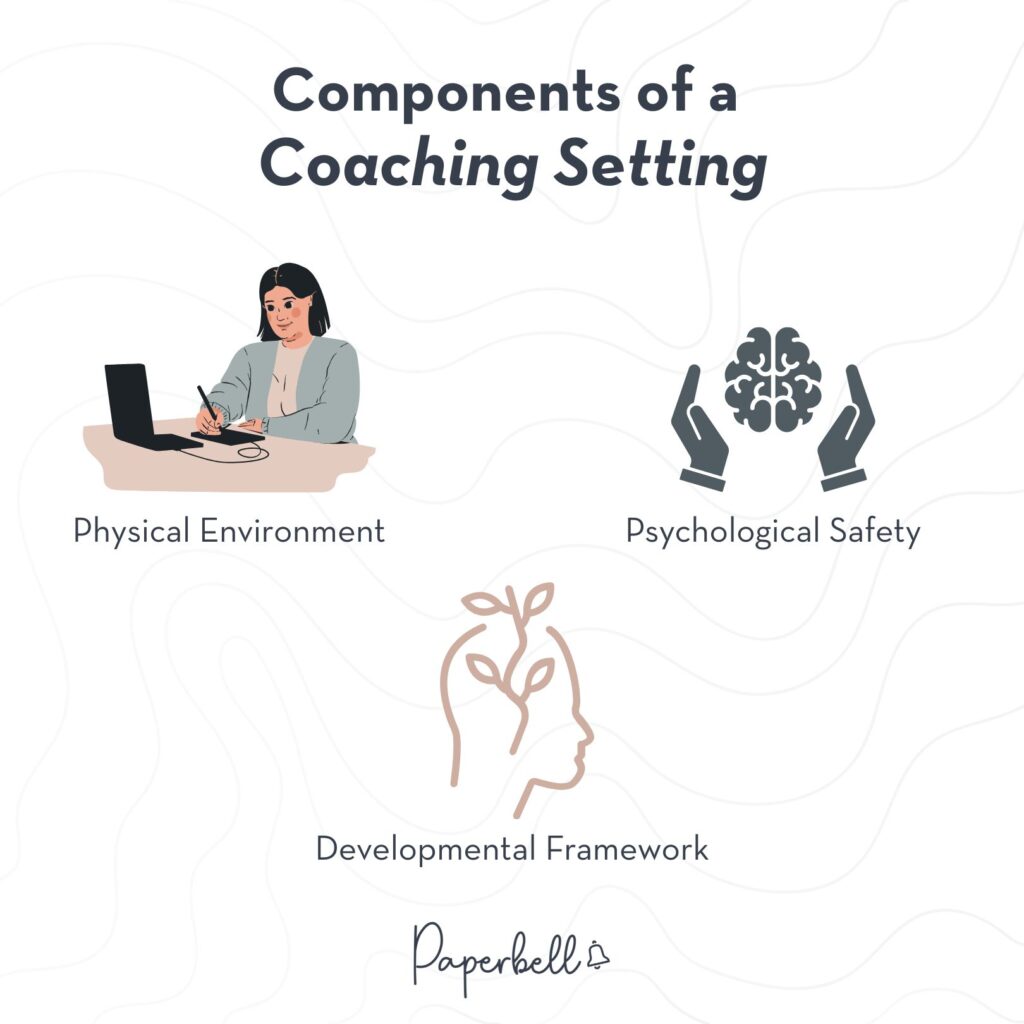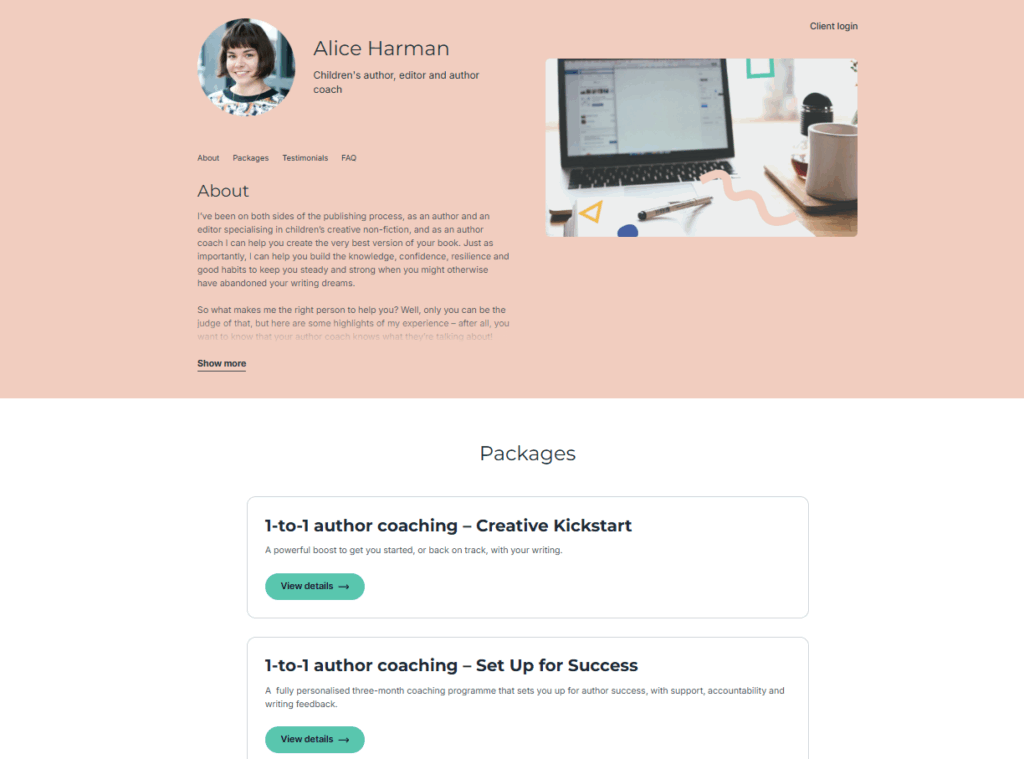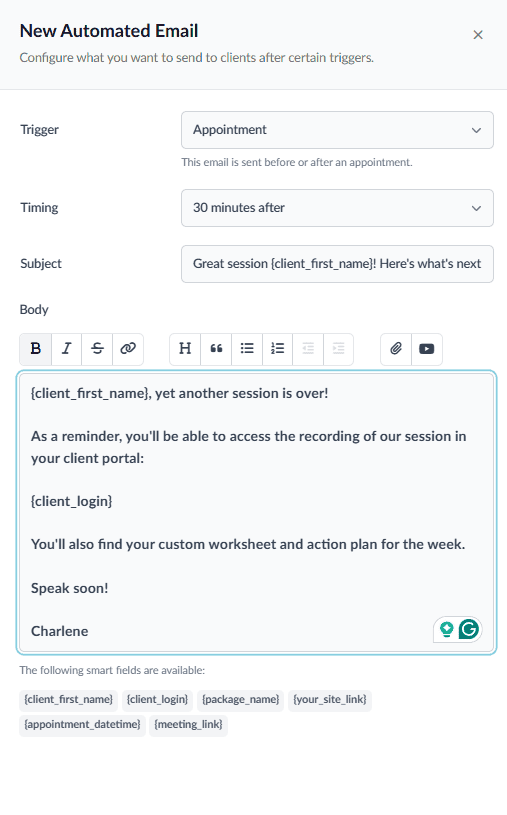If you’re a coach who’s ever felt like something was “off” during a session but couldn’t quite put your finger on it, you might have overlooked one of the most critical aspects of coaching: your coaching setting.
The environment where coaching happens is an active participant in your client’s ability to succeed, not just an afterthought. And the coach setting goes far beyond choosing the right furniture or finding good lighting.
In this guide, you’ll discover how to:
- Create coaching environments that enhance client success in their lives
- Understand the difference between coach settings and coaching goals
- Learn practical steps to optimize both in-person and virtual coaching experiences
What is a Coaching Setting?
A coaching setting refers to both the physical environment and psychological atmosphere you create for your coaching sessions.
It encompasses everything from the room where you meet to the emotional safety your client feels when they sit across from you.
The importance of a coaching setting becomes clear when you consider what happens during coaching. Clients share so much during the collaborative process of coaching, including:
- Their deepest fears
- Biggest dreams
- Most vulnerable moments
They need to feel completely safe to open up and engage in the kind of honest self-reflection that leads to transformation.
The Components of a Coaching Setting

There are 3 key components that make up an effective coach setting:
- Physical Environment: This includes the actual space where coaching takes place, like your office at a 9 to 5 job, a coffee shop, outdoors, or a virtual meeting room.
- Psychological Safety: This refers to the emotional atmosphere you create through your communication style, boundaries, and the trust you build with your client. Your client needs to feel heard, respected, and free from judgment.
- Developmental Framework: This involves the structure and processes you put in place to support your client’s development, including how you organize sessions, track progress, and maintain continuity between meetings.
Keep in mind that your coaching setting is important, whether you’re coaching in person or virtually.
Coach Setting vs Coaching Goal: What’s the Difference?
Coach setting and coaching goals are both essential elements of effective coaching, but they serve completely different purposes.
They shouldn’t be confused with each other.
Coach setting focuses on creating the right environment and space for coaching to happen:
- Focuses on the “where” and “how” of your coaching practice
- Is impacted by the physical space you choose
- Involves the psychological atmosphere you aim to cultivate through your communication style, boundaries, and approach to building trust
Coaching goals, on the other hand, focus on specific outcomes and achievements your client wants to reach:
- Focuses on the “what” of your coaching practice
- Is more about your client’s desired outcomes and what they’re working toward
- Involves both you and the client working together to establish these goals, although clients typically take ownership over their own goals
- Are usually realistic, relevant, time bound, measurable, and achievable for your client
Here’s how they work together: Your coaching setting provides the safe, supportive foundation that allows your client to identify meaningful goals at the beginning of your relationship.
But it also allows them to feel safe to do the work necessary to achieve them.
Without the right setting, even the most well-defined goals can feel overwhelming or unattainable to your client.
For example, imagine a business coach working with an entrepreneur who wants to scale their company. The coaching goal might be:
“Increase revenue by 12% before the new season.”
But if the coaching setting lacks psychological safety, the client might not feel comfortable. They may not admit their fears about delegation or share their past failures with previous business ventures.
In a virtual coach setting, psychological safety might look like:
- Using a reliable video platform with good audio quality
- Ensuring privacy for sensitive conversations
- Establishing clear communication protocols
- Relying on a secure coaching client portal to exchange documents
- In a group coaching setting, establishing rules that make sure everyone feels safe to share during a live course or class
The setting strategies support the goal by creating an environment where honest conversations can happen.
Pro tip: You don’t need to learn to code or get an expensive tool to have your own client portal. Try Paperbell for free to launch your own coaching website, complete with a user-friendly portal your clients will love.
How to Set Up a Coach Setting (Physical Environment)
Creating an effective physical environment for coaching requires thoughtful consideration of how space affects human psychology and comfort.
The right physical setting can help your clients feel relaxed and ready to engage, while the wrong one can create unnecessary stress or distraction.
- Choose the Right Space for In-Person Coaching: Your coaching space should feel professional yet comfortable, and should offer privacy and minimal interruptions. Consider the message your space sends. A cluttered room might signal disorganization, while an overly sterile space can feel clinical rather than supportive.
- Consider Lighting, Seating, and Ambiance: Natural light works best for keeping clients alert and energized. Choose seating that puts you and your client at the same height to avoid power dynamics, and pay attention to ambiance elements like temperature, background noise, and subtle scents that create a welcoming atmosphere.
- Minimize Distractions and Create a Professional Atmosphere: Turn off device notifications and have basic supplies like tissues, water, and paper readily available. If meeting in shared spaces, use white noise machines or schedule sessions during quieter times to maintain focus.
- Implement Flexibility for Different Coaching Styles: Not all coaching happens in traditional office settings. Most people find that walking meetings can spark creativity, while outdoor sessions offer a different energy. Choose quiet, safe routes for walking coaching and always have backup plans for weather or privacy concerns.
The key is matching your physical environment to both your coaching style and your client’s needs and preferences. This will help you create a space that supports meaningful conversation and transformation.
Creating Psychological Safety in Your Coaching Setting
The psychological dimension of your coach setting is arguably even more important than the physical space.
Psychological safety is what allows clients to be vulnerable, honest, and open to change during your sessions together.
- Build Trust and Confidentiality: Start by being absolutely clear about confidentiality and what information you’ll keep private. Trust builds through consistency. Show up as the same person session after session, keep promises, and maintain authenticity while respecting appropriate boundaries.
- Establish Clear Boundaries and Expectations: Set clear expectations about session length, cancellation policies, and communication between sessions so clients can relax into the process. Be explicit about your role as a coach versus other helping professions and have referral resources available when needed.
- Develop Communication Frameworks for Growth: Use empowering language that focuses on strengths and potential while acknowledging challenges. Ask open-ended questions that invite exploration and create space for silence and reflection where important insights often emerge.
- Practice Active Listening and Non-Judgmental Approaches: Maybe most importantly, make sure to reflect back both the content and emotions you hear to help clients feel truly understood. Maintain a curious, non-judgmental attitude even when clients share choices you might personally disagree with. You should focus on supporting their growth rather than approval.
Remember that psychological safety extends beyond sessions to include how you handle:
- Scheduling
- Payment
- Contracts
- Communication between appointments
- And even marketing content they may come across (like your coaching blog)
Every touchpoint either builds or erodes the sense of safety you’re creating for your clients.
Virtual Coach Setting: Best Practices for Online Coaching
The shift to virtual coaching has opened up new possibilities for reaching clients, but it also requires different considerations for creating an effective coaching setting.
A well-designed virtual coach setting can be just as powerful as in-person coaching when done thoughtfully.
- Set Up Reliable Technology and Platforms: Choose a reliable, user-friendly video conferencing platform like Zoom, Google Meet, or Microsoft Teams. Test your internet connection regularly, invest in quality audio equipment, and ensure your platform offers necessary security features like waiting rooms and password protection.
- Create Professional Backgrounds and Lighting: Use clean, non-distracting backgrounds and position your camera at eye level for good eye contact. Natural light from a window facing you works best, but consider a ring light or desk lamp if needed. Ensure your face and upper body are clearly visible in the frame.
- Leverage Digital Tools for Engagement: Take advantage of screen sharing for reviewing documents, digital whiteboards for visual exercises, and collaborative documents for real-time note-taking. Ultimately, it’s vital to encourage clients to use journals during sessions to maintain focus, especially in distracting home environments.
- Make It Easy To Book Their Next Appointments And Coaching Packages: The more put-together you appear online, the easier it will be for a client to trust you. Create streamlined landing pages to showcase your coaching packages, use a scheduling system to automate bookings, and automate appointment reminders so that clients feel secure in remembering their next session with you.
Virtual coaching requires more intentional effort to maintain the human connection that makes coaching effective, but with the right approach, it can be just as transformational as face-to-face sessions.
How to Set Your Coaching Setting with Paperbell
Creating an effective coaching setting involves more than just the physical or virtual space where you meet with clients. The systems and processes you use to manage your coaching practice play a crucial role in the overall experience you create.
Paperbell helps coaches create professional, streamlined coaching environments that support both psychological safety and practical efficiency. When your business systems work smoothly in the background, you can focus entirely on your client during sessions.
Paperbell automatically generates beautiful, branded landing pages for each of your coaching packages. This means potential clients get a professional first impression that sets the tone for your entire working relationship.
Instead of sending clients to a generic booking page, you can share a custom website that showcases:
- Your coaching approach
- What they can expect
- How to get started
- FAQs and testimonials
- Social media links and newsletter opt-ins

This helps establish your credibility and professionalism before your first conversation, which contributes to the psychological safety clients need to feel comfortable opening up during coaching sessions.
When clients can easily understand what they’re signing up for and feel confident in your professionalism, they arrive at your first session more relaxed and ready to engage.
But that’s not all. Paperbell provides each client with their own secure portal where they can manage everything related to their coaching experience. This includes:
- Booking appointments
- Accessing resources you’ve shared
- Reviewing session notes
- Tracking their progress through their coaching package
When clients can easily find information or book their next session without contacting you directly, it preserves the coaching relationship for what it’s meant to be.
Paperbell’s automated email reminders also help ensure clients never miss sessions due to scheduling confusion.
When clients receive timely reminders about upcoming appointments, they can prepare mentally and emotionally for the session, which leads to more productive coaching conversations.

For virtual coach settings, Paperbell integrates with popular video conferencing platforms like Zoom. When clients book a session, the meeting link is automatically included in their calendar invite and reminder emails.
This seamless integration eliminates the common frustration of clients scrambling to find meeting links or coaches having to send last-minute emails with connection information.
These practical systems work together to create an environment where coaching can flourish. It’s the best way to set up your coaching business for success and help your clients achieve massive transformation.
FAQs About Coach Settings
What makes a good coaching setting?
A good coaching setting combines physical comfort with psychological safety. This includes a quiet, comfortable space free from distractions, along with clear boundaries, confidentiality, and a non-judgmental atmosphere that encourages honest conversation.
How do I create psychological safety with new clients?
Start by clearly explaining confidentiality, being consistent in your communication style, asking open-ended questions, and actively listening without judgment. Show genuine interest in your client’s perspective and validate their experiences.
What’s the difference between a coaching setting and a coaching environment?
These terms are often used interchangeably, but the coaching setting typically refers to the specific conditions you create for sessions, while the coaching environment can include broader organizational culture or overall coaching approach within a company.
Can I be effective with virtual coaching settings?
Absolutely. Virtual coaching is effective with reliable technology, professional visual setups, and a strong connection and presence through video platforms. But it’s important to teach clients how to develop the skills and knowledge they need to succeed in this format in the first place.
How do I maintain boundaries in my coaching setting?
Establish clear expectations about session length, communication between sessions, and your role as a coach. Remember that boundary-setting is both your responsibility and part of what makes coaching fun and exciting for clients who thrive with clear structure.
Transform Your Coaching Practice with the Right Setting
Creating an effective coaching setting has nothing to do with renting the fanciest office or investing in expensive technology. Instead, it asks you to become intentional with every element that affects your client’s experience.
When you get your coaching setting right, everything else in your coaching practice becomes easier.
Ready to create a coaching setting that supports your clients’ transformation? Paperbell makes it easy to build the professional systems and processes that improve your coaching environment.
Try Paperbell free today and see how the right tools can elevate your entire coaching practice.










